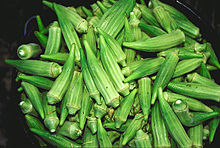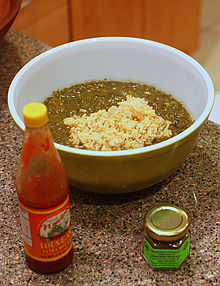



A bowl of shrimp, chicken and sausage gumbo, served over rice
| |
| Place of origin | United States of America, Louisiana Creole people |
|---|---|
| Region or state | Louisiana |
| Main ingredients | Roux, okra, filé powder, meat and/or shellfish, celery, bell pepper |
Creole Gumbo is a dish that originated in southern Louisiana from the Louisiana Creole people during the 18th century. It typically consists primarily of a strongly flavored stock, okra, meat or shellfish, a thickener, and seasoning vegetables, which can include celery, bell peppers and onions. Gumbo is often categorized by the type of thickener used: the African vegetable okra, the Choctaw spice filé powder (dried and ground sassafras leaves), or roux, the French base made of flour and fat. The dish likely derived its name from either the Bantu word for okra (ki ngombo) or the Choctaw word for filé (kombo).
Several different varieties exist. In New Orleans, what is known as Creole gumbo generally ranges from house to house though still retaining its African and Native origins. The Creoles of Cane River make a gumbo focused much more on filé. After the base is prepared, vegetables are cooked down, and then meat is added. The dish simmers, with shellfish and some spices added near the end. Gumbo is traditionally served over rice.
The dish combines ingredients and culinary practices of several cultures, including West African, French, Spanish, German, and Choctaw. Gumbo may have been based on traditional West African or native dishes, or may be a derivation of the French dish bouillabaisse. It was first described in 1802, and was listed in various cookbooks in the latter half of the 19th century. The dish gained more widespread popularity in the 1970s, after the United States Senate cafeteria added it to the menu in honor of Louisiana Senator Allen Ellender. The popularity of Louisiana-born chefs such as Justin Wilson in the 1970s and 1980s spurred further interest in gumbo. The dish is the official cuisine of the state of Louisiana.

Scholars and chefs have offered various explanations for the etymology of the word "gumbo". The dish was likely named after one of its two main ingredients, okra or filé. In the Bantu language spoken by many of the slaves from Central Africa,[citation needed] the vegetable okra was known as ki ngomboorquingombo; [citation needed] the word is akin to the Umbundu ochinggômbo and the Tshiluba chinggômbô "okra". In the language of the native Choctaw people, filé, or ground sassafras leaves, was called kombo.[1][2][3]
Creole Gumbo interacts between all class barriers and ethnicities in the south especially in New Orleans, appearing on the tables of the poor as well as the wealthy.
"Gumbo is a veritable art form in Louisiana. There are as many gumbo recipes as there are cooks.
Gumbo is a heavily seasoned stew-like dish that combines several varieties of meat or seafood with a gravy-like texture.[4] Any combination of either meat or seafood can be used, but not both,[5] with the exception of the traditional New Orleans version that features both seafood and sausage.[6] Meat-based gumbo may consist of chicken, duck, squirrel, rabbitoralligator.[7] Seafood-based gumbo generally has shrimp, crab (whole or meat), and sometimes oysters.[5] With the exception of sausage and ham, beef and pork are almost never used. Most varieties of gumbo are seasoned with onions, parsley, bell pepper, and celery.[5] Today, most of the people are familiar with seafood gumbo and chicken and sausage gumbo.[8]


A roux is traditionally used as a thickener. Ground sassafras leaf, known as filé, is generally not added until after the vegetables and meats and/or seafood are finished cooking and removed from the heat source. The use of filé is optional. The use of okra and tomato is an influence of the Creole (although the tomato was introduced by French chefs in the 19th Century).
The length of cooking time determines the final flavor and texture. The longer the roux is cooked before being added to the gumbo, the darker it becomes and the more prevalent the roux flavor will be. However the more the roux is darkened the less thickening power it will have.

When Catholics were expected to abstain from eating meat during Lent, a meatless variety of gumbo, known as gumbo des herbes (literally "gumbo with herbs" and shortened to gumbo z'herbes), was often served. This variety combined a large number of greens – typically including turnips, mustard greens, and spinach.[9] The greens were cooked to mush and strained through a sieve to produce a thick green liquid. Preparation for this variety of gumbo was time-consuming, and as Lenten restrictions have relaxed, the dish has become less popular.[9] It is very rarely served in restaurants.[10] In modern times, ham or crabmeat is occasionally added to this type of gumbo.
Gumbo z'herbes may have originated with the French, Germans, or West Africans.[11] It has similarities to the French dish potage aux herbes ("soup with herbs"), as well as to the African callaloo.[11] The meatless dish also bears striking resemblance to a dish often eaten in Germany on Maundy Thursday. German Catholics, obeying the Lenten rules, often served a stew made of seven different greens on this date.[10]
Gumbo is often used as a metaphor for the mix of cultures that exist in southern Louisiana.[1] The dish combines the culinary practices of French, Spanish, native tribes, and African slaves, as well as Italians and Germans. In the 18th and 19th centuries, people from these cultures lived together within a fairly small area with minimal mobility. This fostered an environment in which cultures could influence each other and meld to create new traditions and cuisine.[12]
"The dish personifies the word 'Creole'; like its human counterparts, gumbo was born in the New World and took cues from the old but adapted to the new."
Cynthia Lejeune Nobles[1]
The establishment of New Orleans in 1718 marked the beginning of the French colony of Louisiana.[13] French settlers allied with various native tribes, including the Choctaw, Alabama, and Cherokee,from whom they learned new methods of cooking and ways to identify edible indigenous plants.[14]
Slave ships began arriving in Louisiana in 1719. The first ships carried rice and men who were experienced in its cultivation.[15] The grain adapted well to its new environment, and within a few years, rice was commonly grown along the Mississippi River.[10]
In 1721, 125 Germans settled 40 miles (64 km) from New Orleans, and introduced the art of making sausage.[16] By 1746, the white population of Louisiana was estimated to be 3,200, with an estimated 4,730 black people. Slaves outnumbered whites in most areas of Louisiana for at least the next 40 years.[17][18]
The colony was transferred from French to Spanish control in 1762.[10] The Spanish government actively recruited settlers for Spanish Louisiana.[19] About 2,000 people from the Canary Islands moved to the area south of New Orleans.[20][21] These settlers were primarily fishermen who soon began supplying large amounts of shrimp, crab, and oysters to the food markets in New Orleans. The Canary Islanders also brought "a love for well-seasoned food",[22] including use of ground cayenne pepper, a spicy hot red chili pepper.[21] Spanish authorities also granted permission for a large number of French-speaking Acadian exiles to relocate from northeastern North America to Louisiana. From 1755 through 1795, almost 3,000 of these settlers moved to the areas south and west of New Orleans.[22] Louisiana was secretly returned to France in 1800, then purchased by the United States in 1803. The southernmost part of territorial Louisiana, including New Orleans, became the state of Louisiana in 1812.
The new laborers introduced new foods, including the African vegetable okra,[23] and hot pepper plants which likely came from Haiti.[24] Onions and bell peppers were long part of cooking in both the Spanish and African traditions. Tomatoes were introduced to the region shortly thereafter by French chefs of the 19th century, however; aren't traditionally used in gumbo by Creoles.[25]
Scholars agree that gumbo originated in Louisiana with the Creoles in the early 18th century,[1][2]
According to one suggestion, gumbo is a reinterpretation of traditional African cooking. West Africans used the vegetable okra as a base for many dishes, including soups, often pairing okra with meat and shrimp, with salt and pepper as seasonings. In Louisiana, the dish was modified to include ingredients introduced by other cultural groups.Surviving records indicate that by 1764, African slaves in New Orleans mixed cooked okra with rice to make a meal.[10]
Gumbo could instead be a derivation of traditional French soups, particularly the fish stew bouillabaisse.[4][26]
Some culinary experts in the early 20th century, including Celestine Eustis, maintained gumbo was an early special-occasion dish for native tribes.[26] This is further implied by a late 18th-century Creole practice. At that time, rice was a luxury for many Creoles. They served gumbo over corn grits, a pairing common in the stews of native tribes. The use of corn and filé powder may imply the dish was derived from native cuisine.[10]
These theories are intermixed in the local legend of the Frying Pan Revolt, or Petticoat Insurrection. According to legend, in 1722, female French colonists gathered in New Orleans at the home of Governor Jean-Baptiste Le Moyne, Sieur de Bienville, to protest the lack of familiar ingredients. Bienville's housekeeper, Madame Langlois, taught the women how to improve the basic gumbo. Langlois used okra, an ingredient to which the women had previously been introduced by their slaves. Langlois introduced ingredients common in Choctaw cuisine – rice, shrimp, crawfish, and filé powder.[26]
The first written references to gumbo appear in the early 19th century. In 1802, John Sibley described "the dish they call gumbo which is made principally of the ochre into a thick kind of soop [sic] & eat with rice, it is the food of every body for dinner and supper."[27] The following year, French governor Pierre Clement de Laussat hosted a soirée in which 24 different gumbos were prepared. According to author Cynthia Lejeune Nobles, these two events "give clues to gumbo's Spanish colonial popularity and illustrate that the dish could be both humble and refined".[21]
An 1824 cookbook, Mary Randolph's The Virginia House-Wife, was the first to include a recipe for gumbo. Called "Gumbo – A West India Dish", the simple recipe described how to boil okra and bore little resemblance to the stew commonly known as gumbo. The same book contained a recipe for "Ochra Soup" made with okra, onions, fowl, bacon, tomatoes, and lima beans thickened with flour. Although this recipe bore similarities to gumbo, it more closely resembled the Caribbean dish callaloo.[28]
A more familiar version of the dish was described in an 1879 cookbook by Marion Cabell Tyree. Her Housekeeping in Old Virginia described "Gumbo Filit A La Creole", a filé-based gumbo with chicken and oysters and spiced with allspice, cloves, red and black pepper, parsley, and thyme.[28] The 1881 cookbook What Mrs. Fisher Knows About Old Southern Cooking, dictated by former slave Abby Fisher, contained three gumbo recipes. "Oyster Gumbo Soup" used a filé base, while "Ochra Gumbo" and "Chicken Gumbo" used okra as a base.[28] Four years later, the cookbook La Cuisine Creole documented eight varieties of gumbo. None used sausage, but almost all of them contained ham.[22]
Until the 1970s, gumbo was primarily popular on the Gulf Coast of the United States. It gained a broader profile after the death of United States Senator Allen Ellender. A native of Terrebonne Parish, Louisiana, Ellender had often cooked gumbo for his colleagues, including five American presidents. After Ellender died in 1972, the Senate directed its cafeteria to add Louisiana Creole Gumbo, made with seafood, to its menu in his honor. The dish became more widely popular in the 1980s, when chef Paul Prudhomme's popularity spurred interest in Cajun cooking.
Gumbo often simmers all day. Meat (but not seafood) is often browned beforehand and removed from the heat — folklorist John Laudun has commented on the importance of browning not only to the development of gumbo, but also on the flavors found in much of Louisiana foodways.[29] Okra and roux are cooked before other vegetables and seafood. Okra is removed from heat when it reaches the desired consistency, while roux remains in the pot. Seasoning vegetables are then added to the sauce. When these have turned to mush (more commonly called "cooked down"), the meat and okra are added to the pot along with water and/or stock, then boiled uncovered until the desired tenderness of the meat is reached.[9] Seasonings, including red, black, and white pepper, bay leaves, thyme, hot sauce, and salt, are added to taste.[30] According to Nobles, "proper seasoning of gumbo is essential, and in Louisiana adding just the right zing is considered an art".[24] Because seafood cooks fairly quickly, it is not added to the pot until the end of the process. As the gumbo finishes cooking, green onions and parsley are sometimes sprinkled on it. When desired, filé powder is added last.[9]
Creole gumbos are served over hot rice, which helps the dish to feed a larger number of people.[5] Gumbo z'herbes is served with rice on the side.[9] Gumbo is almost always served directly from the pot on the stove, although in wealthier or fancier homes the dish might be transferred to a tureen on the table.[31] Often, gumbo and bread are the sole courses in a meal,[4] although many Acadian families provide a side dish of potato salad.[32] Occasionally, gumbo is served as part of a larger menu.[4]
Soniat gives examples of the main types of creole gumbos, along with descriptions of family traditions about them.[33]
InCajun Foodways, C. Paige Gutierrez describes Creole gumbo as "an economical dish" useful for "feed[ing] a large number of people with a small amount of meat or seafood".[5] Nobles concurs that "one of the hallmarks of Creole gumbo is that, with a big enough pot, it can easily be doubled or tripled and is always a good choice to feed a crowd".[25] With this dish, cooks can use up small portions of various ingredients that were not sufficient for an individual meal. The dish is an efficient way to use up leftover perishable meats and seafood.[5]
Since the 19th century, gumbo has often been served at social gatherings or other special occasions in Louisiana.[23][34] Local fais do-do (dance parties) usually provided gumbo beginning at midnight.[25] Many families "have a gumbo", or host a casual social gathering where friends and family chat and enjoy alcoholic beverages and gumbo.[34]
In rural Acadiana, originally known as the Creole Parishes, in southern Louisiana, gumbo is a central feature of Mardi Gras celebrations. On Mardi Gras, local men wander from house to house and beg for gumbo ingredients in an event known as courir de Mardi Gras.[25] Members of the local community then gather in a central location while the men cook the gumbo. When it is ready, the group eats and dances until midnight, when Lent begins.[28]
Gumbo is the official cuisine of the state of Louisiana.[1] Many southern Louisiana cooking competitions center around gumbo,[34] and it is a central feature of many local festivals.[35] The World Championship Gumbo Cook Off is held annually in New Iberia, Louisiana. The self-described "Gumbo Capital of the World", Bridge City, Louisiana, holds an annual Gumbo Festival.[36] The festival features gumbo cooked in a cast-iron pot 3 ft (0.9 m) deep and 5 feet (1.5 m) in diameter. More commonly, festival gumbo pots measure 2 ft (0.6 m) in depth and diameter.[35]
|
| ||
|---|---|---|
| Fish |
| |
| Shellfish |
| |
| Other seafood |
| |
| Processed seafood |
| |
| Seafood dishes |
| |
| Health hazards |
| |
| Advisory services |
| |
| Animal welfare |
| |
| Related topics |
| |
| ||